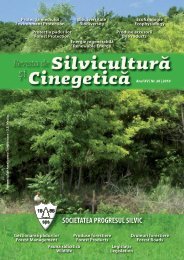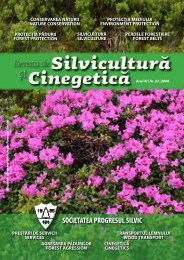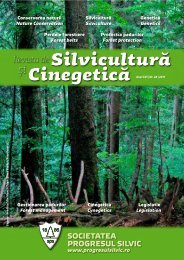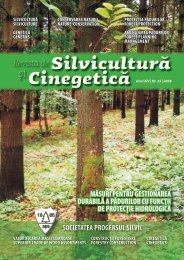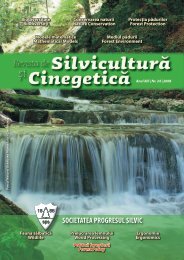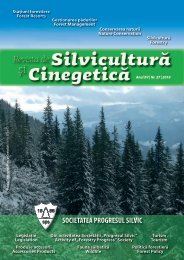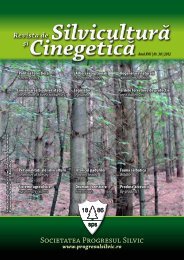Silviculture and Cinegetics Review - Societatea Progresul Silvic
Silviculture and Cinegetics Review - Societatea Progresul Silvic
Silviculture and Cinegetics Review - Societatea Progresul Silvic
You also want an ePaper? Increase the reach of your titles
YUMPU automatically turns print PDFs into web optimized ePapers that Google loves.
FORESTRY BELTS SILVICULTURE AND CINEGETICS REVIEW XVII/30/2012<br />
expected an increase by 600 m of the allocation by<br />
altitude of current primary vegetation.<br />
For the mountain area of our country these bioclimatic<br />
changes by year 2070 are shown in Table 2.<br />
Table 2. Modifications of the bioclimatic <strong>and</strong> vegetation floors at an increase of average air temperature by 3 0 C (forecast<br />
year 2070) (by Maruşca, 2007)<br />
Current floors<br />
Average annual Annual PRECIPITATION Floors (areas)<br />
(areas)<br />
Altitude<br />
TEMPERATURE (mm)<br />
changed after<br />
(m)<br />
( 0 C)<br />
decades<br />
Current Level year 2070 Current Level year 2070<br />
Alpine 2200- 2400 - 1 2 1500 1250 Spruce<br />
Mountain pine 2000-2200 0 3 1450 1150 Spruce<br />
Mountain pine 1800-2000 1 4 1350 1050 Spruce + Beech<br />
Spruce 1600-1800 2 5 1250 950 Beech<br />
Spruce 1400-1600 3 6 1150 850 Beech<br />
Spruce + Beech 1200-1400 4 7 1050 800 Sessile oak<br />
Beech 1000-1200 5 8 950 700 Oaks<br />
Beech 800-1000 6 9 850 600 Forest steppe<br />
Sessile oak 600-800 7 10 800 500 Steppe<br />
(Oaks)<br />
GRADIENTS<br />
(Sub-humid – dry)<br />
(Forest steppe) for 100 m alt. -0.5 0 C -0.5 0 + 45<br />
C<br />
+ 45 mm<br />
(Steppe)<br />
mm<br />
(Semi-arid)<br />
(Arid - deserts)<br />
From these data it results that in the high mountains<br />
the alpine <strong>and</strong> sub-alpine (mountain pine) floors will<br />
disappear, being replaced by the spruce <strong>and</strong> beech<br />
forests floor.<br />
In parallel, the steppe zone will replace the high floor of<br />
the Sessile oak forests <strong>and</strong> the forest steppe will replace<br />
the inferior area of the beech forests floor. These major<br />
mutations in the altitude distribution of woody<br />
vegetation in the mountain area will lead to the natural<br />
reduction 40 – 70 % of the current forest areas, with<br />
dramatic consequences on water balance <strong>and</strong><br />
precipitation.<br />
1.3. Forecast of the changes of mountain soil<br />
Climate change will modify the physic-chemical<br />
properties of soil (Table 3).<br />
Thus, the thickness of soil over the next 60 – 70 years<br />
will be about the same as 1 cm of soil in the temperate<br />
zone forms in approx. 100 years. However, some<br />
agrochemical properties are subject to changes which<br />
term’s is hard to define until they reach a specific<br />
balance imposed by the temperature <strong>and</strong> precipitation<br />
forecasted for year 2070.<br />
Table 3. Modification of soil conditions at an increase of average air temperature by 3 0 C (forecast year 2070)<br />
Current floors<br />
Soil width (cm)<br />
Horizon A<br />
(zones)<br />
Altitude Actual Distant<br />
Water pH V %<br />
(m)<br />
future Actual Near Actual Near future<br />
future<br />
Alpine 2200- 2400 20 3,6 4,5 6 24<br />
Mountain pine 2000-2200 35 3,9 4,8 12 30<br />
Mountain pine 1800-2000 50 4,2 5,1 18 36<br />
Spruce 1600-1800 65 4,5 5,4 24 42<br />
Spruce 1400-1600 80 4,8 5,7 30 48<br />
Spruce + Beech 1200-1400 95 5,1 6,0 36 54<br />
Very slow growth<br />
(approx.1 cm every 100<br />
years)<br />
Beech 1000-1200 110 5,4 6,3 42 60<br />
Beech 800-1000 125 5,7 6,6 48 66<br />
Sessile oak 600-800 140 6,0 6,9 54 72<br />
(Oaks)<br />
GRADIENTS<br />
(Forest steppe)<br />
for<br />
- 7.5 mm<br />
- 0.15 - 0.15 - 3 % - 3 %<br />
75



